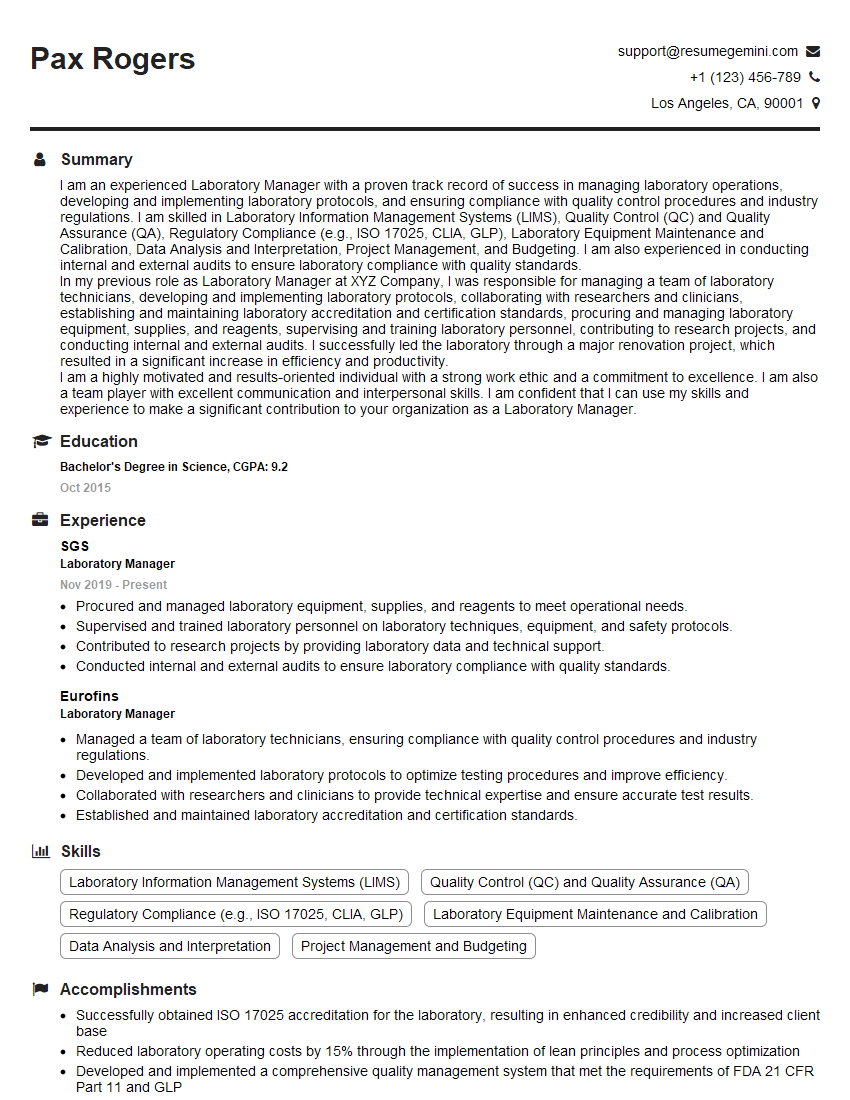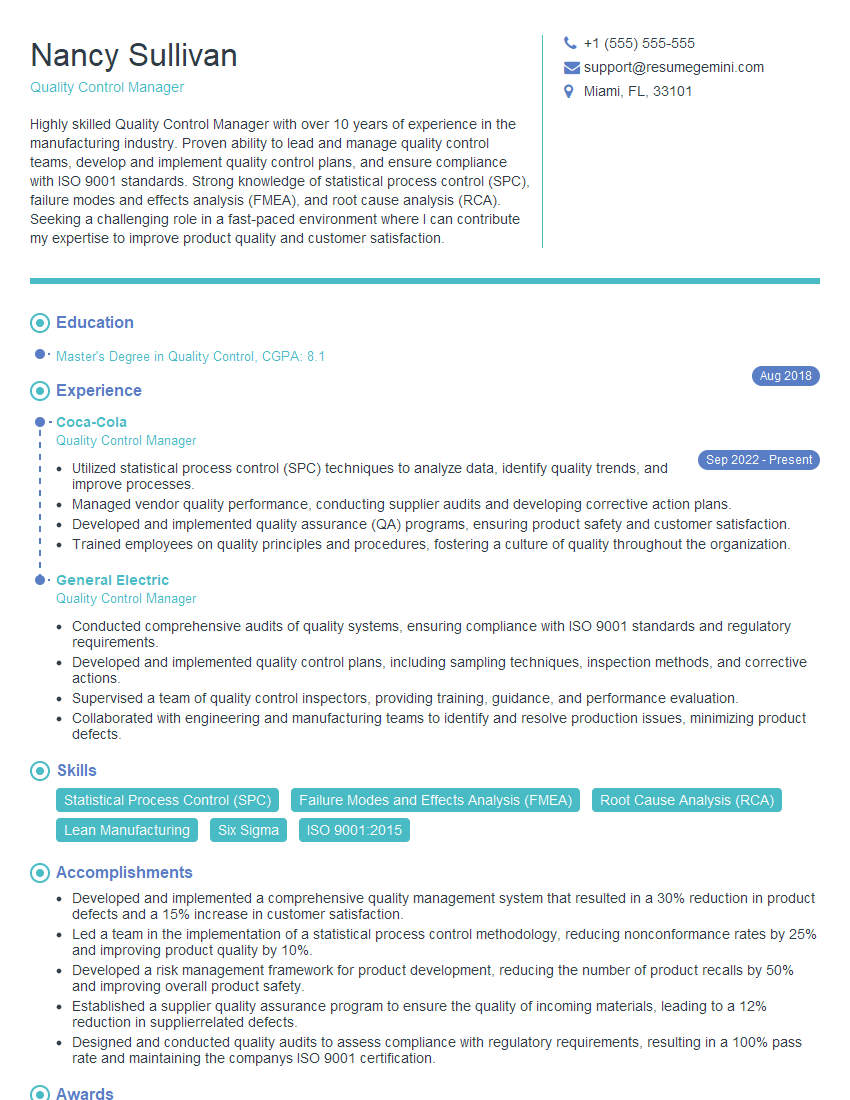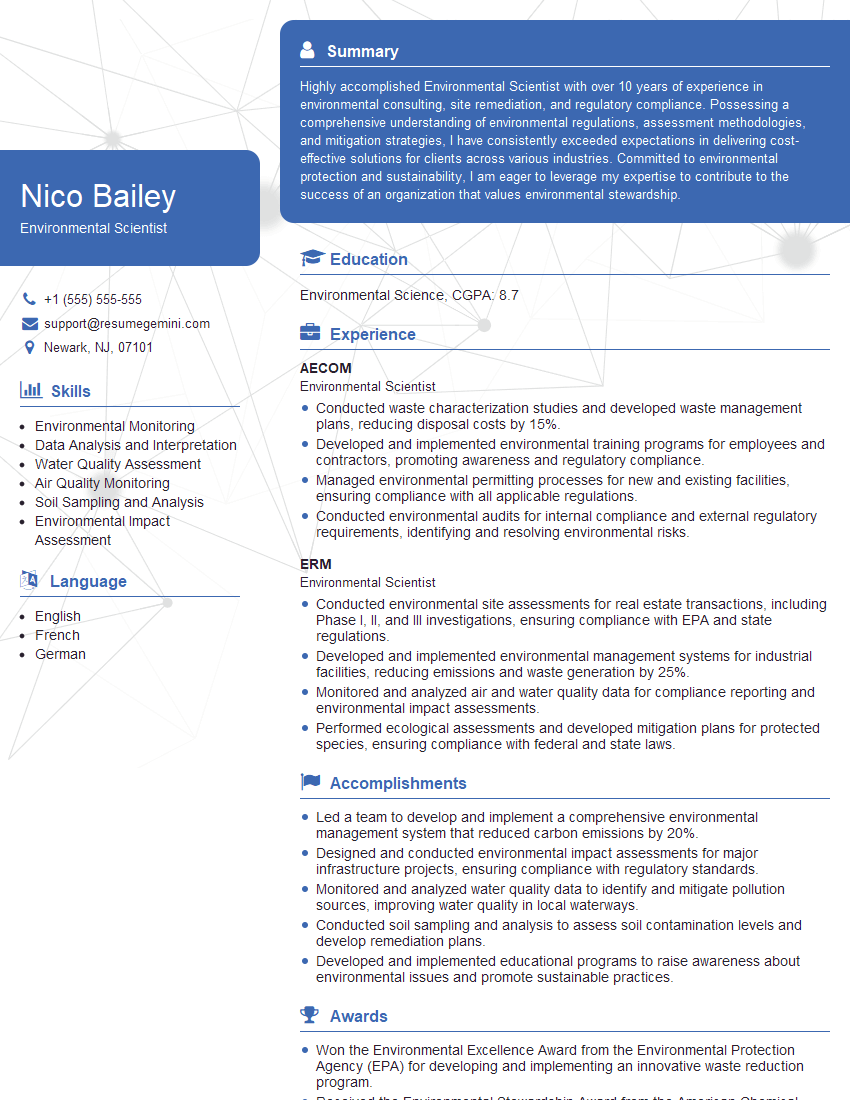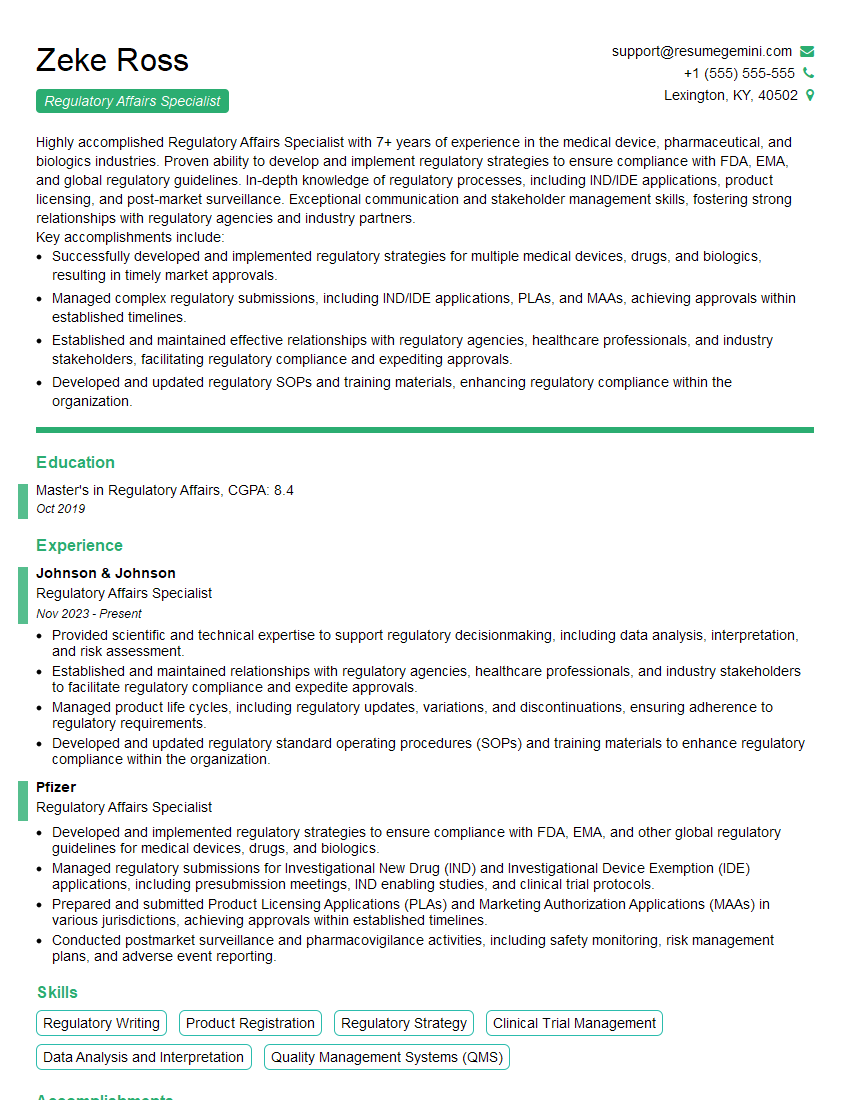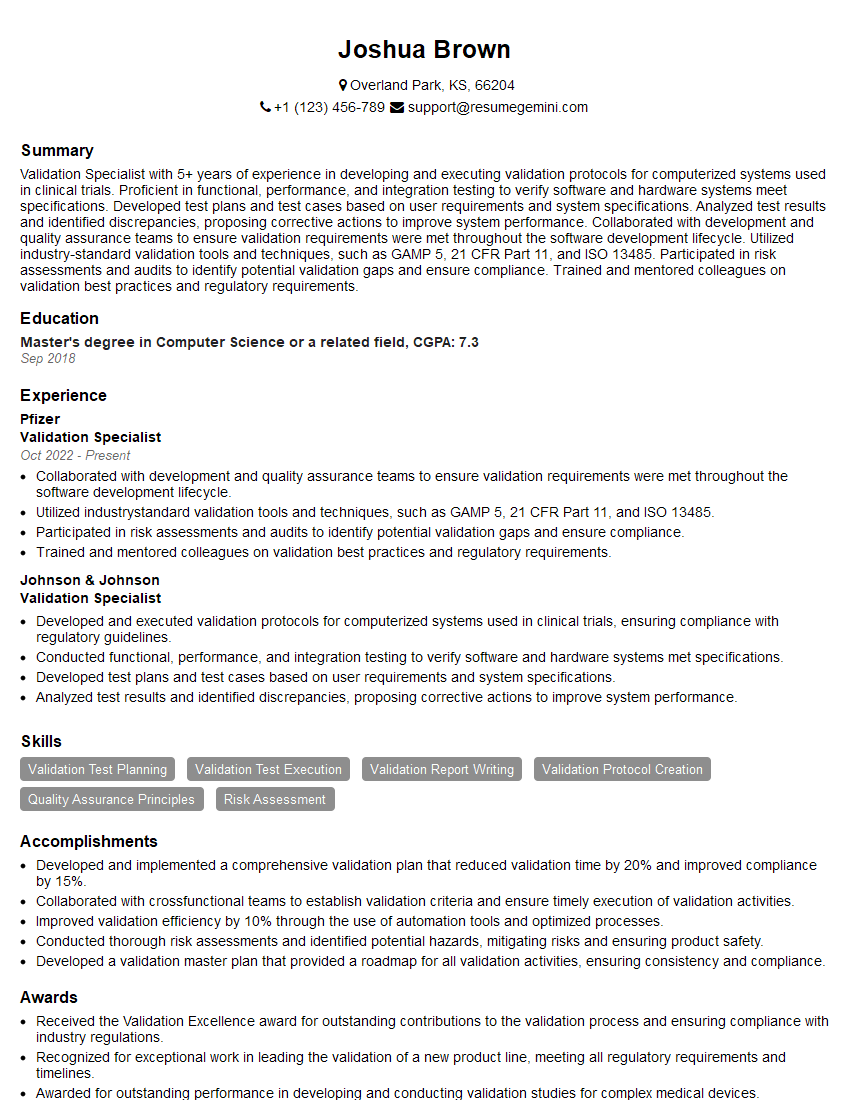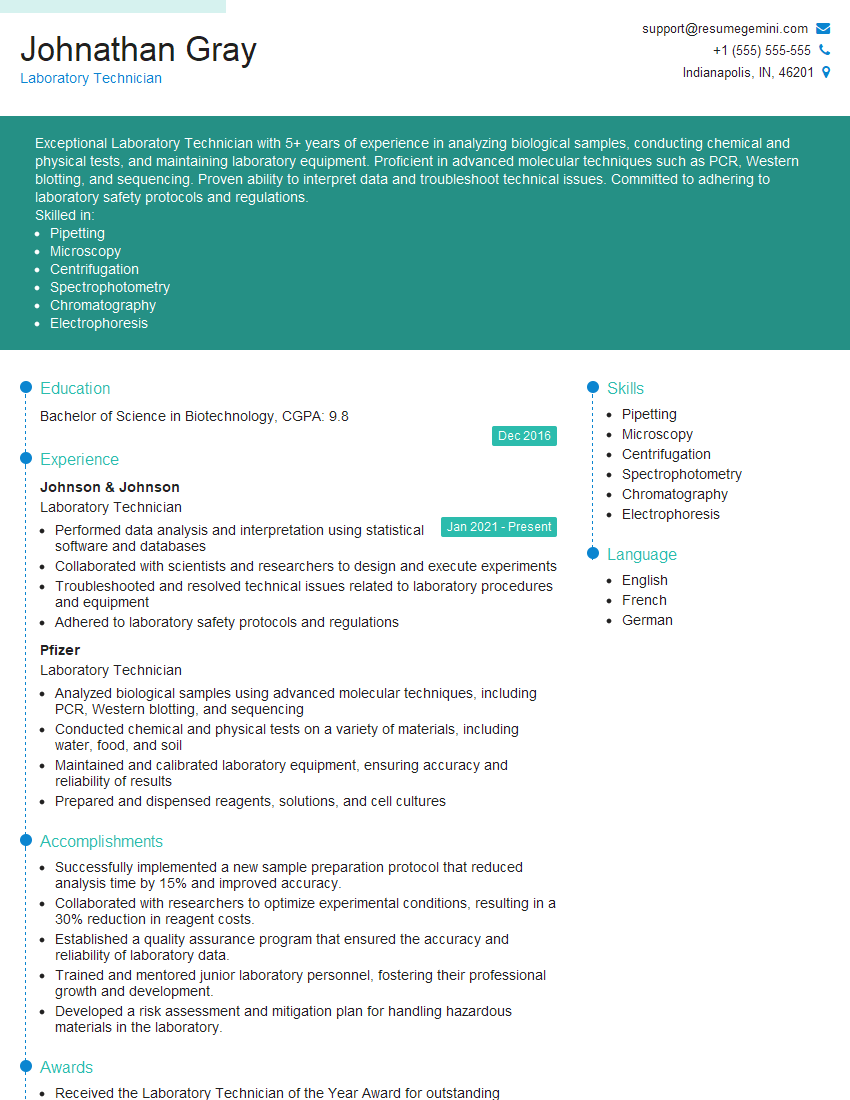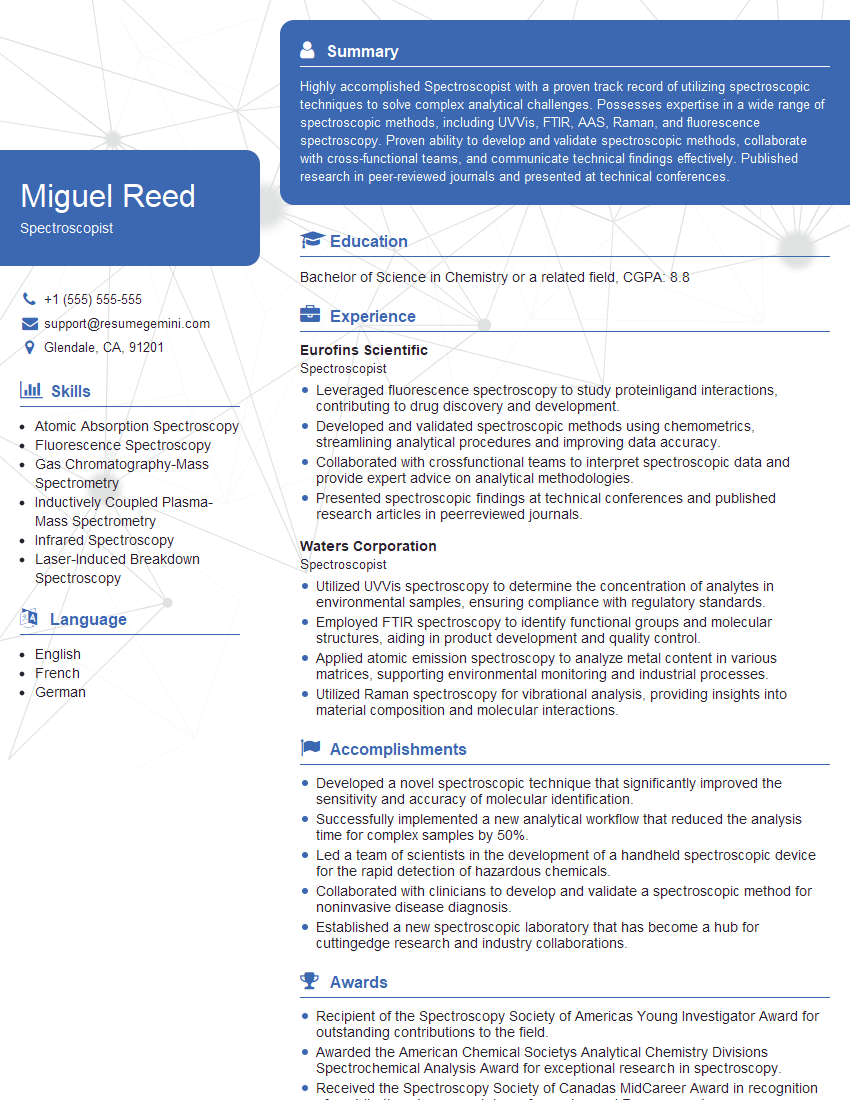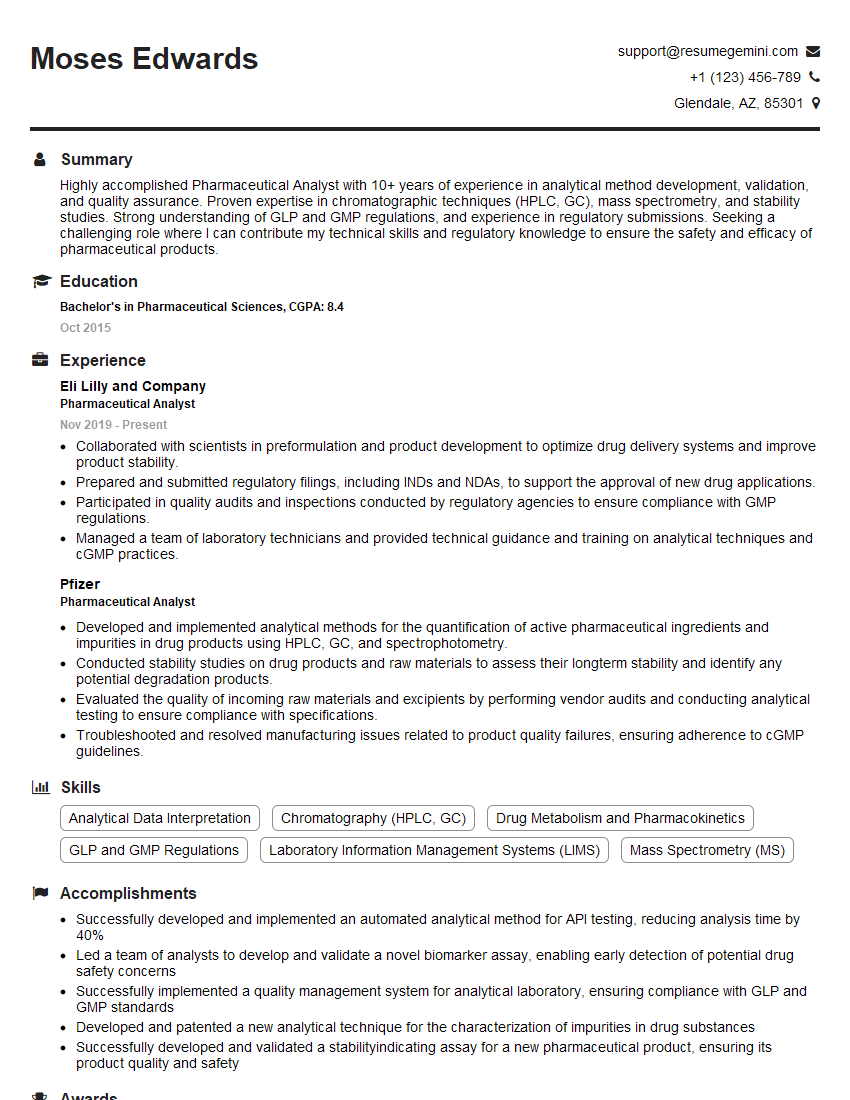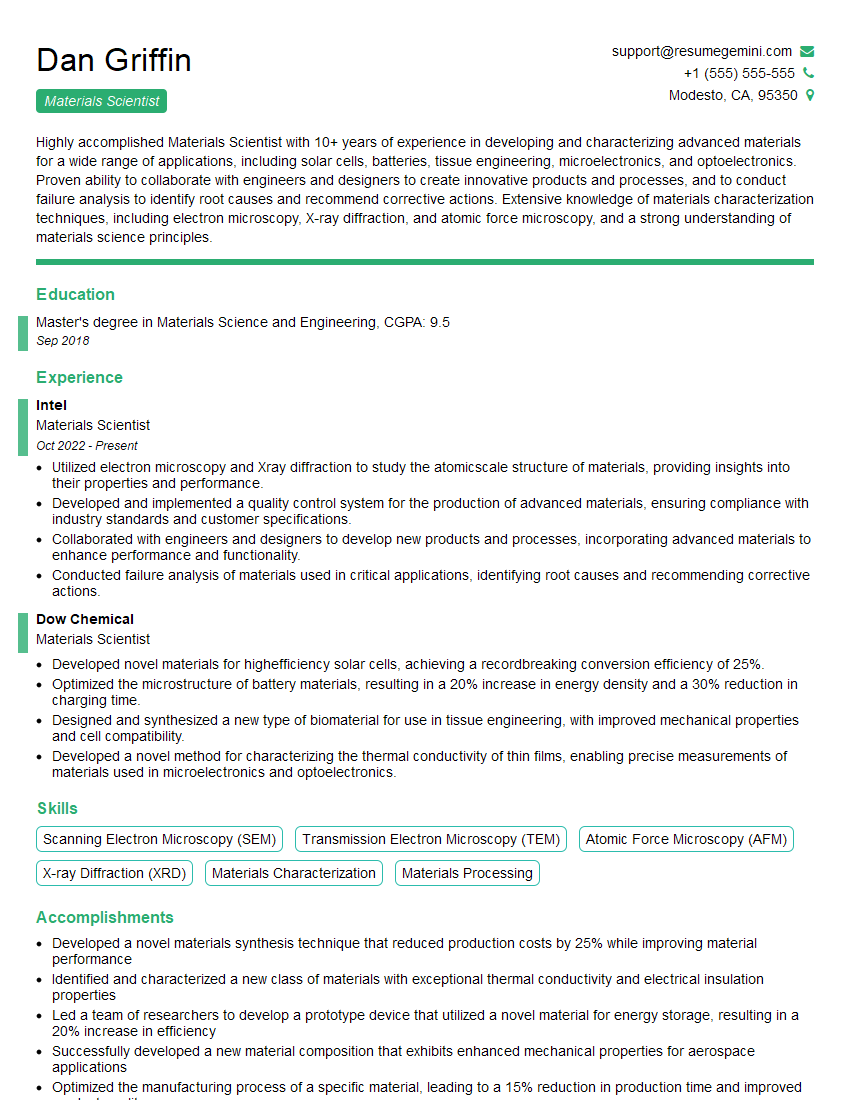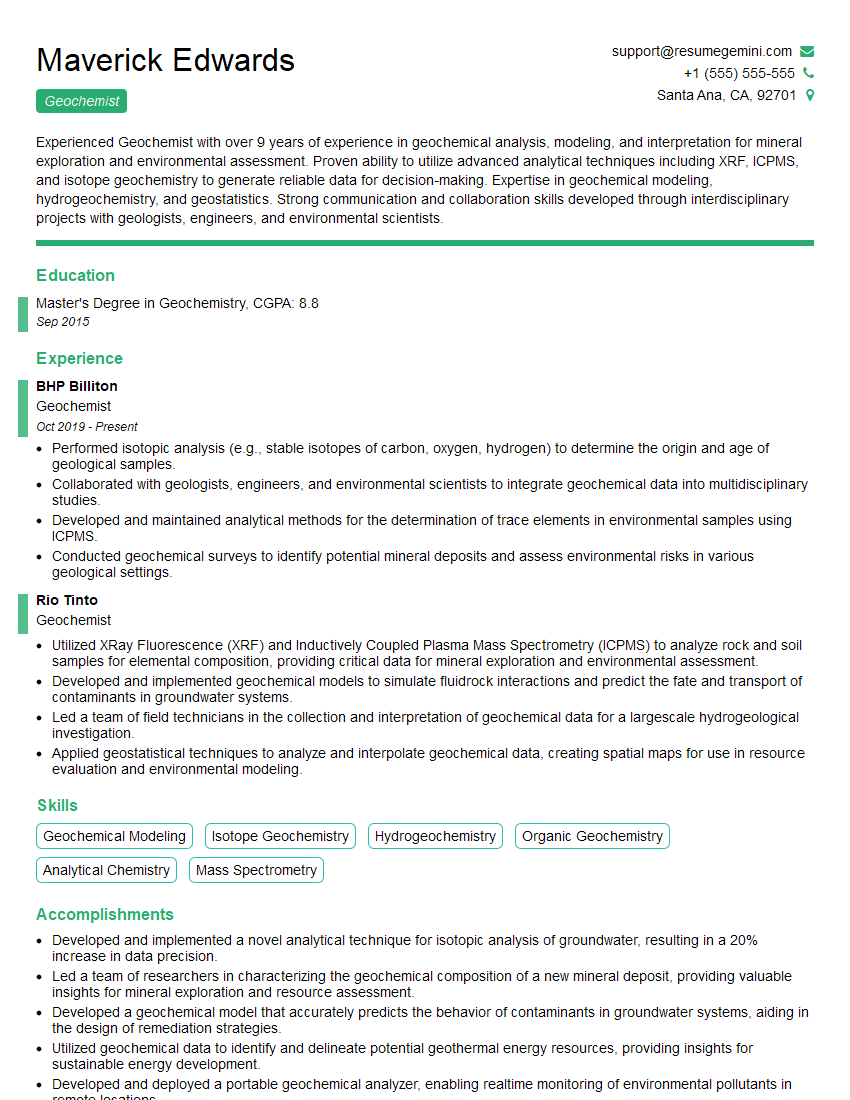Are you ready to stand out in your next interview? Understanding and preparing for Elemental Analysis Techniques (ICP-OES, ICP-MS) interview questions is a game-changer. In this blog, we’ve compiled key questions and expert advice to help you showcase your skills with confidence and precision. Let’s get started on your journey to acing the interview.
Questions Asked in Elemental Analysis Techniques (ICP-OES, ICP-MS) Interview
Q 1. Explain the principle behind ICP-OES.
ICP-OES, or Inductively Coupled Plasma Optical Emission Spectrometry, is a powerful analytical technique used to determine the elemental composition of a sample. It works by atomizing the sample in an incredibly hot argon plasma (around 10,000 Kelvin!), exciting the atoms’ electrons to higher energy levels. When these excited electrons return to their ground state, they emit light at specific wavelengths unique to each element. ICP-OES measures the intensity of this emitted light to quantify the concentration of each element present.
Think of it like a fireworks display: each element produces a characteristic color (wavelength) of light, and the brightness (intensity) corresponds to the amount of that element present. By analyzing the spectrum of emitted light, we can identify and quantify the elements in the sample with high precision.
The process typically involves introducing a liquid sample (though solid samples can be analyzed after appropriate digestion) into the argon plasma using a nebulizer. This creates a fine mist that is efficiently atomized and excited. The emitted light then passes through a diffraction grating that separates the light into its component wavelengths, which are then detected by a photomultiplier tube. The resulting signal is directly proportional to the analyte concentration.
Q 2. Describe the principle behind ICP-MS.
ICP-MS, or Inductively Coupled Plasma Mass Spectrometry, also uses an argon plasma to atomize and ionize a sample, but instead of measuring emitted light, it measures the mass-to-charge ratio of the ions produced. This allows for the detection of elements based on their mass, providing a highly sensitive and versatile technique for elemental analysis.
After the sample is atomized and ionized in the plasma, the ions are passed through a mass spectrometer. This instrument separates the ions based on their mass-to-charge ratio, using electromagnetic fields. A detector then measures the abundance of each ion, providing a quantitative measure of the elements present. Imagine it like a sophisticated sorting machine that separates ions based on their ‘weight’.
The sensitivity of ICP-MS is particularly high, allowing for the detection of trace elements even at parts-per-trillion levels. This makes it an invaluable tool in various fields, including environmental monitoring, food safety, and geological analysis.
Q 3. What are the differences between ICP-OES and ICP-MS?
Both ICP-OES and ICP-MS use an inductively coupled plasma to atomize and excite/ionize a sample, but they differ significantly in their detection methods. ICP-OES measures the emission of light, while ICP-MS measures the mass of ions. This fundamental difference leads to several key distinctions:
- Detection Method: ICP-OES detects emitted light, ICP-MS detects ions.
- Sensitivity: ICP-MS generally offers significantly higher sensitivity, particularly for trace elements, than ICP-OES.
- Isotope Analysis: ICP-MS is capable of isotope ratio measurements, a feature not available in ICP-OES.
- Linearity: ICP-OES often exhibits better linearity over a wider concentration range.
- Cost: ICP-MS systems are typically more expensive than ICP-OES systems.
- Matrix Effects: Both techniques can suffer from matrix effects, but the nature and extent of these interferences differ.
In essence, the choice between the two techniques depends on the specific analytical needs of the application. If high sensitivity and isotopic analysis are required, ICP-MS is preferred. If a wider linear range, simpler operation, and lower cost are prioritized, ICP-OES may be more suitable.
Q 4. What are the advantages and disadvantages of ICP-OES?
Advantages of ICP-OES:
- Relatively inexpensive: ICP-OES instruments are generally less expensive than ICP-MS systems.
- Robust and reliable: They are known for their robustness and require less maintenance.
- Wide linear range: ICP-OES offers a good linear dynamic range, enabling analysis of samples with varying concentrations.
- Simultaneous multi-element analysis: Many elements can be determined simultaneously.
- Relatively easy to operate and maintain: Compared to ICP-MS, training and maintenance are less complex.
Disadvantages of ICP-OES:
- Lower sensitivity: Compared to ICP-MS, detection limits are higher.
- Susceptible to spectral interferences: Overlapping emission lines can complicate analysis.
- Limited isotopic information: It cannot distinguish between isotopes of an element.
For example, ICP-OES is commonly used for routine analysis of major and minor elements in environmental samples like water or soil where high sensitivity isn’t crucial.
Q 5. What are the advantages and disadvantages of ICP-MS?
Advantages of ICP-MS:
- High sensitivity: Can detect elements at very low concentrations (ppt level).
- Isotope ratio measurements: Allows for isotopic analysis, which is crucial in various applications, including geochronology and environmental tracing.
- Wide range of element analysis: Can analyze a vast range of elements, including refractory elements.
- Relatively little spectral interference: Minimizes the impact of spectral overlaps.
Disadvantages of ICP-MS:
- High cost: The equipment is significantly more expensive than ICP-OES.
- More complex operation and maintenance: Requires specialized training and more frequent maintenance.
- Susceptible to isobaric interferences: Ions with the same mass-to-charge ratio can interfere with each other.
- Matrix effects: The sample matrix can influence ionization efficiency.
A typical application where ICP-MS excels is the determination of trace elements in biological samples, where low concentration detection is vital.
Q 6. What are the common interferences encountered in ICP-OES?
Common interferences in ICP-OES can be broadly classified into spectral and chemical interferences.
Spectral Interferences: These occur when the emission lines of different elements overlap, making it difficult to distinguish between them. For instance, the emission line of one element might partially or completely overlap with the emission line of another, leading to an overestimation or underestimation of its concentration.
Chemical Interferences: These arise from the sample matrix affecting the excitation or ionization efficiency of the analyte. For example, the presence of certain compounds might reduce the atomization or excitation of the target element, resulting in a lower signal intensity. This can be caused by ionization suppression or the formation of refractory compounds.
Strategies to mitigate these interferences include using appropriate background correction methods, employing different plasma operating conditions, or using chemical separation techniques to pre-treat the samples.
Q 7. What are the common interferences encountered in ICP-MS?
ICP-MS suffers primarily from isobaric and matrix interferences.
Isobaric Interferences: These occur when different elements produce ions with the same mass-to-charge ratio. For example, 40Ar+ can interfere with 40Ca+, making it challenging to accurately quantify calcium in the presence of argon. This is a significant concern as Argon is the plasma gas.
Matrix Effects: The sample matrix can affect the ionization efficiency and the transport of ions through the instrument. These effects can lead to both signal enhancement and suppression. For example, a high concentration of easily ionized elements (like alkali metals) can suppress the ionization of other elements.
Strategies to address these interferences include using collision/reaction cells to remove interfering ions, employing internal standardization, and using appropriate sample preparation techniques to minimize matrix effects.
Q 8. How do you prepare samples for ICP-OES analysis?
Sample preparation for ICP-OES is crucial for accurate results. It involves dissolving the sample into a liquid solution, typically an acid matrix, that the instrument can handle. The goal is to completely break down the sample matrix to release the analytes (elements being measured) into solution. The method chosen depends heavily on the sample type.
- Solid Samples: These often require digestion using strong acids (like HNO3, HCl, HF) either through microwave digestion (faster, more controlled) or hotplate digestion (simpler, but potentially more time-consuming and requires careful monitoring). For instance, soil samples might need a multi-acid digestion to release trace metals.
- Liquid Samples: These are generally simpler to prepare; they may require simple dilution or filtration to remove particulate matter before analysis. For example, a water sample may need only to be filtered to remove solids that could clog the nebulizer.
- Biological Samples: These often require more complex procedures, such as ashing (burning off organic matter) or wet digestion, to remove interfering organic compounds before analysis. Consider blood samples requiring a careful digestion process to avoid analyte loss.
Once dissolved, the solution is diluted to an appropriate concentration range for the instrument, ensuring the analyte concentration falls within the calibration range. It’s vital to maintain accuracy and precision throughout the sample preparation to avoid introducing contamination or analyte loss.
Q 9. How do you prepare samples for ICP-MS analysis?
Sample preparation for ICP-MS is similar to ICP-OES, but with a greater emphasis on minimizing contamination and matrix effects. ICP-MS is far more sensitive than ICP-OES, so even trace contaminants can significantly impact results. The goal is to obtain a clean, homogeneous solution, free of polyatomic interferences.
- Acid Selection: The choice of acid is crucial. Ultra-pure acids (sub-boiling distilled) are essential to reduce contamination. Often, a mixture of acids is used to optimize dissolution and minimize interferences.
- Clean Techniques: Stringent cleanliness is paramount, using clean labware (acid-washed, ideally), and working in a clean environment to prevent contamination. This might include using a clean bench or laminar flow hood.
- Matrix Matching: Matching the matrix of standards to the sample matrix is important to minimize matrix effects. This helps ensure accurate quantification.
- Separation Techniques: In some cases, sample pre-concentration or separation techniques (like ion exchange chromatography) might be needed, especially for trace elements in complex matrices. For example, separating certain analytes from a high salt matrix is essential.
Ultimately, achieving a clean and accurately diluted sample is vital for reliable ICP-MS analysis, and meticulous attention to detail during sample preparation significantly impacts the quality of the data generated.
Q 10. Explain the role of the nebulizer in ICP-OES.
The nebulizer in ICP-OES plays a critical role in transforming the liquid sample into a fine aerosol that can be efficiently introduced into the plasma. Think of it as a spray bottle that creates a very fine mist. The aerosol’s size and distribution significantly influence the sensitivity and stability of the analysis.
Different types of nebulizers exist, each with its own advantages and disadvantages, such as concentric, cross-flow, and ultrasonic nebulizers. The nebulizer’s efficiency directly affects how much sample reaches the plasma for excitation and subsequent detection. A poorly performing nebulizer can lead to poor signal intensity and inaccurate results. The efficiency depends on factors such as the sample viscosity and the gas flow rate.
In essence, the nebulizer is the critical interface between the sample introduction system and the plasma in ICP-OES. Its proper functioning is fundamental to obtaining quality data.
Q 11. Explain the role of the plasma in ICP-OES and ICP-MS.
The plasma in both ICP-OES and ICP-MS is the heart of the instrument, responsible for atomizing and ionizing the sample. It’s a high-temperature, electrically conductive gas (usually Argon) that is created by inducing a radio frequency (RF) field between two electrodes.
In ICP-OES: The plasma excites the atoms in the sample, causing them to emit light at characteristic wavelengths. The intensity of this light is directly proportional to the concentration of the analyte. The plasma’s temperature needs to be high enough to fully atomize the sample (breaking down molecules into individual atoms) and to excite a significant proportion of these atoms to emit light.
In ICP-MS: The plasma ionizes the atoms, producing charged particles (ions). These ions are then passed through a mass spectrometer, which separates them based on their mass-to-charge ratio. The abundance of each ion is directly proportional to the concentration of the corresponding element. Similar to ICP-OES, achieving optimal plasma conditions is vital for sensitivity and accurate quantitative results. The plasma in ICP-MS needs to effectively ionize the elements for accurate mass measurements.
In both techniques, maintaining a stable and efficient plasma is vital for reliable and reproducible results. Factors affecting the plasma include the gas flow rate, RF power, and the sample introduction rate.
Q 12. How is calibration performed in ICP-OES?
Calibration in ICP-OES involves creating a calibration curve by measuring the signal intensity of a series of standards with known concentrations. These standards should ideally span the expected concentration range of the analytes in the samples.
The process typically involves:
- Preparation of Standards: Accurately preparing a series of standards with known concentrations of the target analytes in a matrix similar to the samples.
- Measurement: Measuring the signal intensity for each standard under the same conditions as the samples.
- Calibration Curve Construction: Plotting the signal intensity (y-axis) against the concentration (x-axis) of each standard. A linear regression is typically performed to obtain the equation of the line, which relates the signal intensity to the concentration.
- Sample Measurement: Measuring the signal intensity of the unknown samples under the same conditions as the standards.
- Concentration Determination: Using the calibration curve equation to determine the concentration of the analytes in the samples based on their measured signal intensities.
Regular calibration checks and quality control samples are essential to ensure the accuracy and reliability of the results. For example, a known standard might be run periodically during the analysis to verify the calibration.
Q 13. How is calibration performed in ICP-MS?
Calibration in ICP-MS is similar to ICP-OES but with additional considerations due to the mass spectrometer’s sensitivity and potential for isobaric interferences (ions with the same mass-to-charge ratio). The calibration curve relates the analyte signal to its concentration, but the process often involves internal standardization to correct for instrumental drift and matrix effects.
The process includes:
- Preparation of Standards: Preparing a series of standards with known concentrations of the target analytes, often containing an internal standard.
- Internal Standard Selection: Choosing an internal standard (an element not present in the sample) to correct for variations in instrumental response. It needs a similar behavior to the analytes in the plasma.
- Measurement: Measuring the signal intensities of both the analytes and the internal standard for each standard and sample.
- Calibration Curve Construction: Plotting the ratio of the analyte signal to the internal standard signal against the analyte concentration. This helps correct for signal drift.
- Sample Measurement & Calculation: Measuring the samples and using the calibration curve to determine the analyte concentrations corrected for matrix effects and instrumental drift. The ratio is used to calculate the concentration.
Careful selection of internal standards and regular calibration checks are critical for obtaining accurate results in ICP-MS, as variations in instrument response can significantly affect the outcome.
Q 14. What are internal standards and why are they used?
Internal standards are elements added to both samples and standards in equal concentrations before analysis, primarily in ICP-MS (but sometimes used in ICP-OES). They act as a corrective measure to account for variations in instrumental response and sample introduction efficiency.
Why are they used?
- Instrumental Drift Compensation: Instrumental drift, due to changes in plasma conditions, nebulizer efficiency or detector response, can affect the signal intensity over time. The internal standard helps correct for these drifts by providing a reference signal.
- Matrix Effect Correction: The sample matrix (the composition of the sample aside from the analytes) can influence the ionization efficiency of the analytes. The internal standard helps account for these matrix effects.
- Improved Accuracy and Precision: By normalizing the analyte signal to the internal standard signal, the accuracy and precision of the measurements are significantly improved.
Example: If analyzing heavy metals in environmental samples, an element like Indium (In) or Rhodium (Rh) might be chosen as an internal standard because they are not typically found in such samples, and they behave similarly to the target heavy metals in the plasma. By comparing the ratio of each analyte to the internal standard, you can compensate for various systematic errors during analysis.
Q 15. Explain the concept of spectral and non-spectral interferences.
In elemental analysis using ICP-OES and ICP-MS, interferences are phenomena that affect the accuracy and precision of measurements. They can be broadly classified into spectral and non-spectral interferences.
Spectral interferences occur when the analyte’s emission or ion signal overlaps with another element’s signal in ICP-OES or ICP-MS, respectively. This overlap makes it difficult to accurately measure the analyte’s concentration. For example, in ICP-OES, the emission line of iron (Fe) at 259.94 nm might overlap with the emission line of another element, leading to an overestimation of iron concentration if not corrected. Similarly, in ICP-MS, isobaric interferences arise when two isotopes have the same mass-to-charge ratio, creating a signal that includes contributions from both isotopes. For instance, 40Ar16O interferes with 56Fe, a common isobaric interference that can significantly affect iron measurements in ICP-MS unless a correction method like collision/reaction cell technology is used.
Non-spectral interferences, also known as matrix effects, are caused by the sample matrix itself. These interferences affect the analyte’s transport efficiency, excitation/ionization, and signal generation without direct spectral overlap. Examples include chemical ionization suppression or enhancement (where the presence of easily ionized elements alters ionization efficiency of the analyte), viscosity effects that alter sample introduction rate, and scattering effects affecting signal transmission. Imagine trying to measure the volume of a single grain of sand in a bucket of water. The water itself affects our ability to accurately measure the sand, analogous to matrix effects impacting analyte signals.
Career Expert Tips:
- Ace those interviews! Prepare effectively by reviewing the Top 50 Most Common Interview Questions on ResumeGemini.
- Navigate your job search with confidence! Explore a wide range of Career Tips on ResumeGemini. Learn about common challenges and recommendations to overcome them.
- Craft the perfect resume! Master the Art of Resume Writing with ResumeGemini’s guide. Showcase your unique qualifications and achievements effectively.
- Don’t miss out on holiday savings! Build your dream resume with ResumeGemini’s ATS optimized templates.
Q 16. How do you correct for matrix effects in ICP-OES and ICP-MS?
Matrix effects are a significant challenge in ICP-OES and ICP-MS. Several strategies are employed to mitigate them:
- Standard additions method: This involves adding known amounts of the analyte to aliquots of the sample and measuring the signal increase. By extrapolating back to zero added analyte, the corrected concentration can be determined. This is extremely effective as it accounts for all matrix effects.
- Internal standard method: An element not present in the sample is added in a known concentration. The analyte signal is then normalized to the internal standard signal, effectively compensating for variations in transport efficiency, etc. Choosing an appropriate internal standard is crucial, requiring a similar behaviour as the analyte in the plasma.
- Matrix matching: The standard solutions are prepared to have a similar composition to the sample. This approach reduces matrix effects by matching the physical and chemical properties of the standards and samples, minimizing systematic differences in signal response.
- Isotope dilution method (ICP-MS only): A known amount of isotopically enriched analyte is added to the sample. This method is exceptionally precise and accurate, accounting for almost all forms of interference, but requires access to enriched isotopes.
The choice of method depends on the nature of the matrix, the analyte concentration, and the required accuracy. A combination of approaches is often used to get the best results.
Q 17. What are the detection limits of ICP-OES and ICP-MS?
Detection limits in ICP-OES and ICP-MS vary greatly depending on the specific element, the instrument used, and the sample matrix. Generally, ICP-MS boasts significantly lower detection limits than ICP-OES.
ICP-OES: Detection limits typically range from µg/L (parts per billion) to mg/L (parts per million) for many elements. For some elements, particularly those with weak emission lines or prone to significant interferences, higher detection limits might be observed.
ICP-MS: Detection limits can reach ng/L (parts per trillion) or even lower for many elements, representing a significant advantage over ICP-OES, particularly for trace element analysis. This superior sensitivity is due to the higher ionization efficiency and superior background rejection capabilities of ICP-MS.
It’s important to note that these are just general ranges. Specific detection limits should be determined experimentally for each element and matrix through calibration curves and analysis of blanks.
Q 18. What are the common maintenance procedures for ICP-OES?
Regular maintenance is critical for optimal performance and longevity of an ICP-OES instrument. Key procedures include:
- Daily: Checking gas flows (argon), observing plasma stability, rinsing the sample introduction system (nebulizer, torch, etc.) thoroughly with deionized water and acid.
- Weekly: Cleaning the nebulizer and torch, inspecting for any signs of wear and tear. Thorough cleaning with an appropriate acid (e.g., nitric acid) will remove deposits that build-up and lead to signal drift or blockage.
- Monthly: More intensive cleaning, potentially requiring dismantling components of the nebulizer system for thorough cleaning using ultrasonic bath or manual cleaning. Inspecting the optical system, checking for dust or debris. It is important to ensure the optical system is not damaged during cleaning.
- Periodically (depending on usage): Replacing consumables like the torch, nebulizer, and pump tubing. The frequency depends on sample matrix composition and usage intensity.
Regular maintenance logs should be kept to track all procedures and to identify potential issues before they become critical.
Q 19. What are the common maintenance procedures for ICP-MS?
ICP-MS requires a more stringent maintenance schedule due to its higher sensitivity and more complex components. Key procedures include:
- Daily: Checking gas flows (argon, reaction/collision gas if applicable), monitoring the vacuum, tuning the instrument to optimize sensitivity and minimize oxide formation. Regular sample introduction system rinsing is also critical.
- Weekly: Cleaning the cones (sampler and skimmer cones) and torch using appropriate cleaning solutions, paying close attention to avoid damaging these delicate parts. Monitoring and adjusting lens voltages as necessary.
- Monthly: More thorough cleaning of the interface region, checking the performance of the ion lens system, and verifying vacuum integrity and pump performance.
- Periodically: Replacing the cones, torch, and other consumables. In addition, the internal components, such as the quadrupole rods, requires occasional cleaning or reconditioning by manufacturer specialized service technicians.
Because of the sensitivity to contamination, strict cleanliness protocols in sample preparation and laboratory environment are crucial.
Q 20. How do you troubleshoot common problems in ICP-OES?
Troubleshooting ICP-OES often involves a systematic approach. Let’s consider some common problems and their solutions:
- Low signal intensity: Check gas flows, nebulizer function, torch alignment, and sample introduction system. Clogged nebulizer, worn torch, or misalignment can significantly reduce signal. Cleaning or replacing components may be needed.
- Unstable signal: Issues with gas flow stability, sample uptake, or plasma instability need investigation. Check for leaks in the gas lines, pump operation, and plasma ignition stability. Ensure efficient sample delivery through proper nebulizer adjustment.
- Spectral interference: If the problem is an overlap in emission lines, spectral line selection, chemical separation of interfering elements, or advanced mathematical background correction techniques need to be used.
- High background: This might indicate contamination of the system or poor background correction. Thorough cleaning of the system and checking the background correction method should be addressed.
A detailed record of instrument parameters, sample conditions, and diagnostic steps aids troubleshooting.
Q 21. How do you troubleshoot common problems in ICP-MS?
Troubleshooting ICP-MS is more complex due to its sensitivity and vacuum requirements. Common problems and solutions include:
- Low sensitivity/signal: Check vacuum, gas flows, cone alignment and cleanliness. Contaminated cones or poor vacuum significantly impact sensitivity. Cleaning or replacement of cones may solve the issue.
- High background: This can result from contamination or incorrect mass calibration. Thorough system cleaning and verification of mass calibration are vital.
- Polyatomic interferences: Collision/reaction cell technology, alternative mass numbers, or mathematical corrections are utilized to reduce or compensate for the interference.
- Drifting signals: This often points to issues with the ion optics or matrix effects. Optimizing the instrument tuning, using an internal standard or standard additions method, or cleaning the cones and other ion optics can be helpful.
- Vacuum leaks: Vacuum leaks dramatically impact instrument performance. Systematic checking of all vacuum connections and seals is crucial to locate the leak.
For more complex issues, consulting the instrument’s manual, manufacturer’s support, or experienced ICP-MS specialists is often necessary.
Q 22. Explain the difference between radial and axial viewing in ICP-OES.
In ICP-OES (Inductively Coupled Plasma Optical Emission Spectrometry), both radial and axial viewing refer to the angle at which the emitted light from the plasma is observed. The difference lies in the path of light detection and consequently, the sensitivity and matrix effects observed.
Radial viewing observes the light emitted from the plasma at a right angle (90 degrees) to the plasma torch. This configuration offers a broader view of the plasma, integrating signals from a larger volume. While it’s less sensitive, it often shows improved stability and reduced matrix effects – meaning less interference from other elements in the sample.
Axial viewing observes the light emitted along the axis of the plasma torch. Because it directly looks through the hottest and most optically dense region of the plasma, it offers significantly higher sensitivity, particularly for analytes present at lower concentrations. However, axial viewing is more susceptible to matrix interferences, requiring careful optimization of the analytical conditions and potentially the use of internal standards to correct for this variability.
Think of it like looking at a campfire. Radial viewing is like looking at the fire from the side – you see a lot of the fire, but less intense light. Axial viewing is like looking directly into the heart of the fire – much brighter, but a smaller view. The choice depends on the analytical goals: high sensitivity for trace element analysis often favors axial viewing, while minimizing matrix effects in complex samples might favor radial viewing.
Q 23. Describe different sample introduction techniques used in ICP-OES and ICP-MS.
Sample introduction in both ICP-OES and ICP-MS is crucial for accurate and precise analysis. Several methods exist, each with its own advantages and disadvantages.
- Nebulization: This is the most common method, using a pneumatic nebulizer to create a fine aerosol of the sample solution, which is then carried into the plasma. Different nebulizer types exist, such as concentric, cross-flow, and ultrasonic, each offering varying sensitivity and robustness. For example, ultrasonic nebulizers enhance sensitivity but are more prone to clogging.
- Electrothermal Vaporization (ETV): A small sample volume is heated in a graphite furnace, vaporizing the analytes which are then transported into the plasma. ETV significantly improves sensitivity compared to nebulization, particularly useful for trace analysis and solid samples. However, it is often slower than nebulization and can suffer from matrix effects.
- Hydride Generation (HG): Specific for volatile hydrides (e.g., arsenic, selenium), this technique generates gaseous hydrides using a reducing agent, improving sensitivity and reducing matrix interferences. It’s crucial for determining trace elements that form volatile hydrides, like As and Se in environmental waters.
- Direct Solid Sampling (DSS): Eliminates the need for sample digestion. The solid sample is directly introduced into the plasma, using laser ablation or other techniques. This is rapid and minimizes sample preparation, crucial for field studies and large-sample analyses. However, it can be challenging to ensure homogeneity and control the sample introduction rate.
- Flow Injection (FI): Samples are injected into a carrier stream that transports it to the plasma. This improves precision and reduces sample consumption, ideal for small sample volumes. It can also be coupled with various sample preparation methods.
The optimal technique is selected based on the sample matrix, analyte concentration, and desired sensitivity. For example, ETV is excellent for trace analysis of heavy metals in blood, while nebulization is commonly used for routine analysis of water samples.
Q 24. What are the applications of ICP-OES in environmental analysis?
ICP-OES finds extensive application in environmental analysis due to its ability to determine multiple elements simultaneously with high sensitivity. Key applications include:
- Water quality monitoring: Determining trace metals (e.g., lead, cadmium, mercury) and nutrients (e.g., phosphorus, nitrogen) in drinking water, wastewater, and surface water to ensure compliance with environmental regulations.
- Soil analysis: Assessing the levels of heavy metals and essential elements in soil samples to assess contamination levels and soil fertility. This helps monitor the impact of industrial activities or agricultural practices.
- Air quality monitoring: Analysis of particulate matter to identify and quantify the trace metals present, helping understand air pollution sources and their health implications. Often involves sample collection using filters followed by acid digestion before ICP-OES analysis.
- Waste characterization: Determining the elemental composition of various waste materials (e.g., industrial sludge, incinerator ash) to assess its potential environmental impact and guide waste management strategies. This is critical for proper disposal and waste recycling.
ICP-OES’s ability to handle various sample matrices (after appropriate preparation) and its relatively low cost compared to ICP-MS make it an invaluable tool in environmental monitoring programs worldwide.
Q 25. What are the applications of ICP-MS in food safety?
ICP-MS (Inductively Coupled Plasma Mass Spectrometry) is a powerful technique for food safety analysis, primarily due to its high sensitivity and ability to detect a wide range of elements. Some key applications include:
- Determination of heavy metal contaminants: Assessing the levels of toxic elements like lead, arsenic, cadmium, and mercury in various food products to ensure compliance with food safety regulations and protect consumer health. These elements can accumulate in the food chain, posing serious risks.
- Nutrient analysis: Determining essential elements like iron, zinc, and selenium in food to assess nutritional value and ensure adequate intake in the diet. This is important for nutritional labeling and public health.
- Detection of food adulteration: ICP-MS can identify unexpected elements in food, potentially indicating adulteration or contamination with industrial materials. For instance, detecting high levels of lead in spices could suggest contamination.
- Traceability and origin verification: Elemental fingerprints in food products can be used for authenticity checks, helping identify the origin of food and prevent fraud. Isotopic ratios determined by ICP-MS can be particularly helpful in this application.
The high sensitivity of ICP-MS is vital for detecting trace contaminants in complex food matrices, contributing to safer food supplies and informed consumer choices.
Q 26. How do you ensure the accuracy and precision of your results?
Ensuring accuracy and precision in elemental analysis using ICP-OES and ICP-MS involves a multi-faceted approach that starts with meticulous sample preparation and continues through data acquisition and analysis:
- Proper Sample Preparation: This is paramount. Thorough digestion of samples using appropriate acids is crucial to ensure complete dissolution of the analytes. Using certified reference materials (CRMs) throughout the process allows for calibration and quality control checks, comparing results to expected values.
- Calibration and Standardization: Calibration curves using standard solutions of known concentrations are essential. Regular checks using CRMs ensure the accuracy of the calibration. Internal standard addition can help correct for matrix effects and instrumental drift, improving accuracy.
- Quality Control (QC) Samples: Regular insertion of QC samples (blanks, duplicates, and CRMs) throughout the analytical run allows monitoring of precision and accuracy. Analysis of blanks helps identify contamination sources, while duplicates assess the reproducibility of measurements.
- Method Validation: Formal method validation according to relevant standards (e.g., ISO 17025) is crucial. This includes evaluating aspects such as linearity, limit of detection, accuracy, and precision of the method. This ensures reliable and defensible results.
- Data Analysis and Interpretation: Proper statistical analysis of the data is necessary, including calculation of uncertainties and consideration of potential sources of error. Software packages built into the instrumentation usually handle this, but it’s crucial to understand the data analysis performed.
By systematically implementing these steps, we can confidently claim the accuracy and precision of the results obtained, minimizing the risk of false positives or negatives.
Q 27. Explain your experience with quality control and quality assurance in elemental analysis.
My experience with quality control (QC) and quality assurance (QA) in elemental analysis is extensive, covering all aspects from initial sample receipt to final report generation. I’ve worked under ISO 17025 accreditation standards, emphasizing rigorous documentation, traceability, and compliance.
My responsibilities included:
- Developing and implementing robust QC procedures, including the use of CRMs, blanks, and duplicates, to monitor method performance and detect potential errors.
- Regular calibration and maintenance of instruments, ensuring their optimal performance. Logbooks meticulously track instrument performance, calibrations, and maintenance.
- Participating in proficiency testing programs to assess the accuracy of our results against external laboratories and confirm our lab’s competency.
- Reviewing and approving analytical data before reporting, ensuring accuracy, precision, and adherence to established quality guidelines. This often involves reviewing QC data and flagging potential outliers or issues.
- Training and mentoring junior analysts in proper QC procedures and ensuring data integrity. This is crucial for maintaining consistent quality across the team.
My commitment to QC/QA ensures that all analysis performed meets the highest standards of accuracy, precision, and reliability.
Q 28. Describe a situation where you had to troubleshoot a complex analytical problem.
During the analysis of trace elements in seawater samples, we encountered unusually high blank values for several elements. This initially indicated contamination, but cleaning and recalibration didn’t resolve the issue. The problem was particularly puzzling because the results were inconsistent—some blanks were high, others normal.
Our troubleshooting steps included:
- Systematic Investigation: We systematically examined all aspects of the analytical process, including the acids used for digestion, the sample containers, the laboratory environment, and even the water used for rinsing glassware. This involved testing each component individually.
- Traceability and Documentation: A detailed review of the lab logbook helped us pinpoint when the problem started. This revealed a recent change in the acid supplier and the batch number of the acid used for the problematic samples.
- Supplier Contact and Testing: Contacting the acid supplier and requesting a new sample of the acid, and analyzing it confirmed the presence of high concentrations of the problematic elements in that particular batch of acid. This was the root cause.
- Corrective Actions: After identifying the contaminated acid, we replaced it with a new batch from a different supplier and repeated the analyses. The blank values returned to normal, and the results became consistent and reliable. The lab’s procedure now includes additional checks for impurities in purchased reagents.
This experience highlighted the importance of a thorough and methodical approach to troubleshooting, paying close attention to details and documenting every step of the investigation. It also demonstrated the importance of using validated methods, properly trained personnel, and a system of quality control checks to ensure accurate results.
Key Topics to Learn for Elemental Analysis Techniques (ICP-OES, ICP-MS) Interview
- Instrumentation: Understand the fundamental principles of ICP-OES and ICP-MS instrumentation, including sample introduction systems, plasma generation, and detection methods. Consider the differences and similarities between the two techniques.
- Spectroscopy Principles: Grasp the theoretical underpinnings of atomic emission (ICP-OES) and mass spectrometry (ICP-MS). Be prepared to discuss spectral interferences and their mitigation.
- Sample Preparation: Master various sample preparation techniques, including digestion, dilution, and matrix matching. Understand the impact of sample preparation on analytical results.
- Method Development and Validation: Be familiar with the process of developing and validating analytical methods, including calibration, quality control, and accuracy assessment.
- Data Analysis and Interpretation: Practice interpreting analytical data, including identifying potential sources of error and applying appropriate statistical analysis.
- Practical Applications: Explore the diverse applications of ICP-OES and ICP-MS across various industries (e.g., environmental monitoring, food safety, materials science). Be ready to discuss specific examples.
- Troubleshooting: Familiarize yourself with common instrumental problems and troubleshooting strategies for both ICP-OES and ICP-MS.
- Method Comparison: Understand the strengths and limitations of ICP-OES and ICP-MS, and when to choose one technique over the other.
- Safety Procedures: Be prepared to discuss safety protocols and regulations related to the handling of hazardous materials and operation of ICP-OES and ICP-MS instruments.
- Data Quality Assurance/Quality Control (QA/QC): Thoroughly understand QA/QC procedures and their importance in ensuring reliable analytical results.
Next Steps
Mastering Elemental Analysis Techniques like ICP-OES and ICP-MS significantly enhances your career prospects in analytical chemistry and related fields, opening doors to diverse and challenging roles. A strong, ATS-friendly resume is crucial for showcasing your skills and experience effectively to potential employers. To maximize your job search success, consider using ResumeGemini – a trusted resource for crafting professional and impactful resumes. ResumeGemini provides examples of resumes tailored to Elemental Analysis Techniques (ICP-OES, ICP-MS), helping you present your qualifications compellingly.
Explore more articles
Users Rating of Our Blogs
Share Your Experience
We value your feedback! Please rate our content and share your thoughts (optional).
What Readers Say About Our Blog
Hi, I represent a social media marketing agency that creates 15 engaging posts per month for businesses like yours. Our clients typically see a 40-60% increase in followers and engagement for just $199/month. Would you be interested?”
Hi, I’m Jay, we have a few potential clients that are interested in your services, thought you might be a good fit. I’d love to talk about the details, when do you have time to talk?
Best,
Jay
Founder | CEO
Hi, I represent an SEO company that specialises in getting you AI citations and higher rankings on Google. I’d like to offer you a 100% free SEO audit for your website. Would you be interested?
Hi, I represent an SEO company that specialises in getting you AI citations and higher rankings on Google. I’d like to offer you a 100% free SEO audit for your website. Would you be interested?
Dear Sir/Madam,
Do you want to become a vendor/supplier/service provider of Delta Air Lines, Inc.? We are looking for a reliable, innovative and fair partner for 2025/2026 series tender projects, tasks and contracts. Kindly indicate your interest by requesting a pre-qualification questionnaire. With this information, we will analyze whether you meet the minimum requirements to collaborate with us.
Best regards,
Carey Richardson
V.P. – Corporate Audit and Enterprise Risk Management
Delta Air Lines Inc
Group Procurement & Contracts Center
1030 Delta Boulevard,
Atlanta, GA 30354-1989
United States
+1(470) 982-2456
